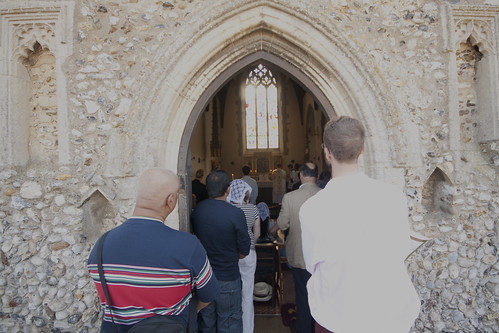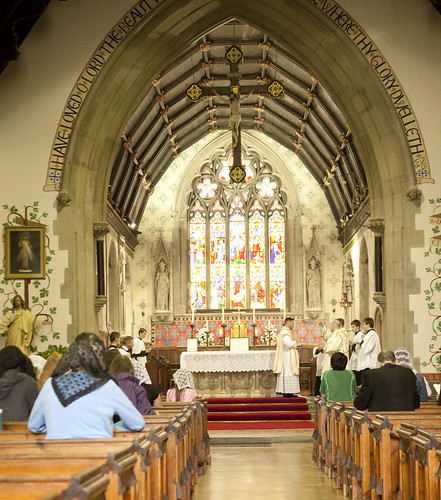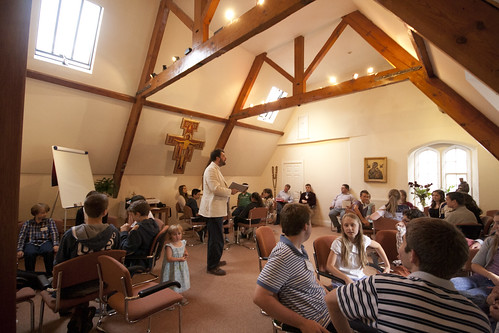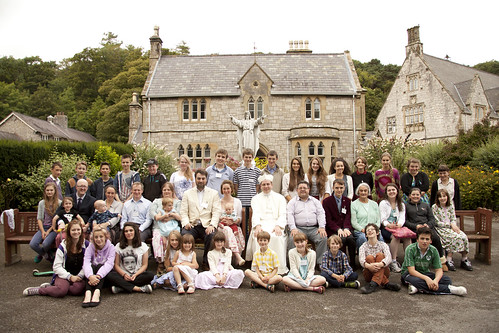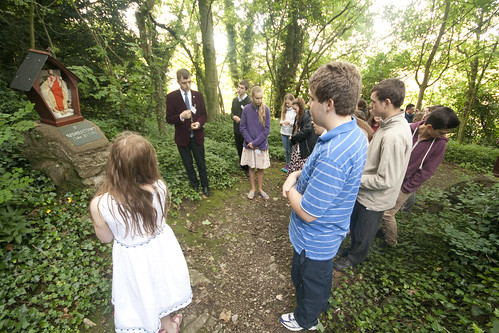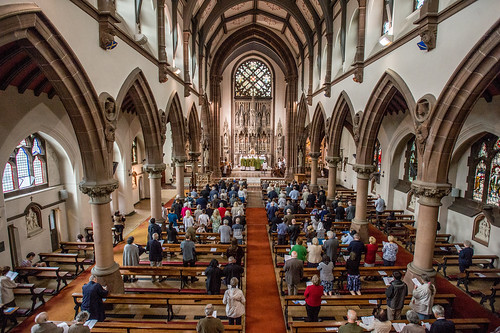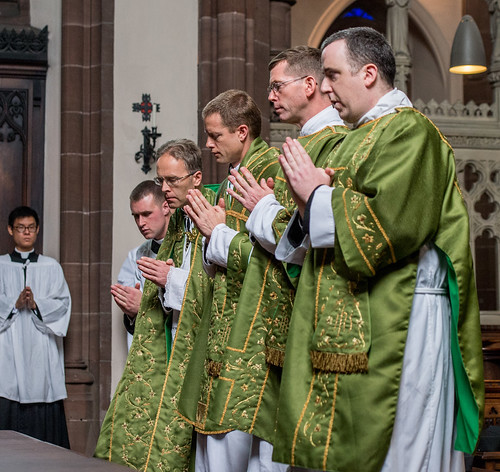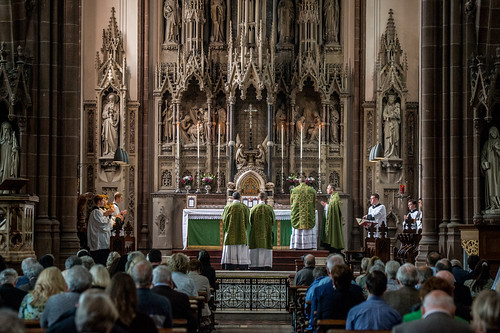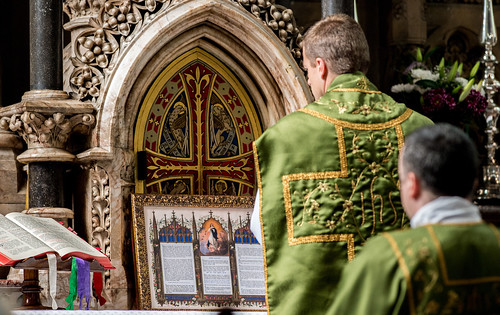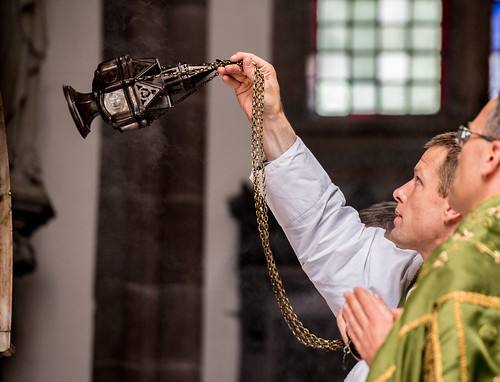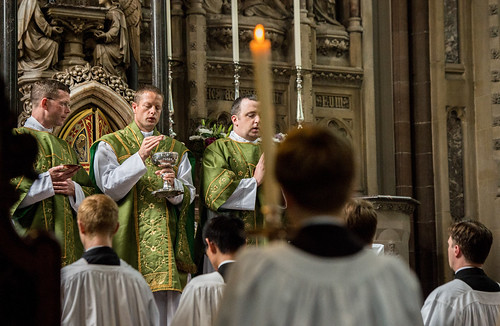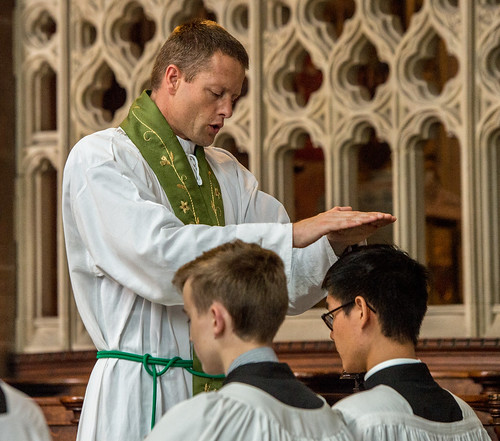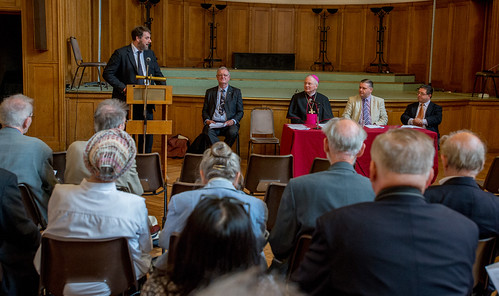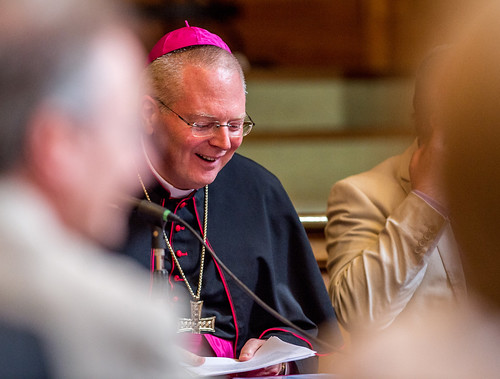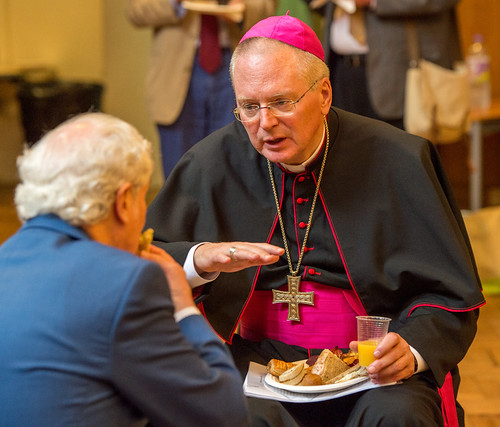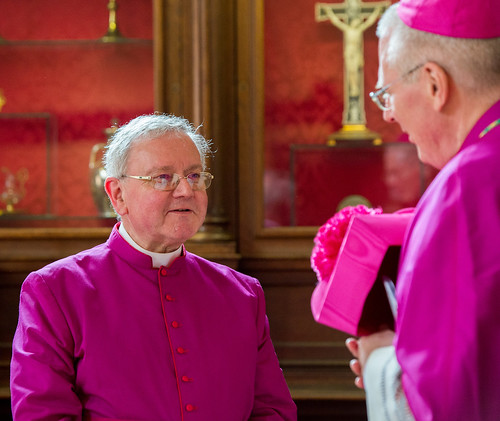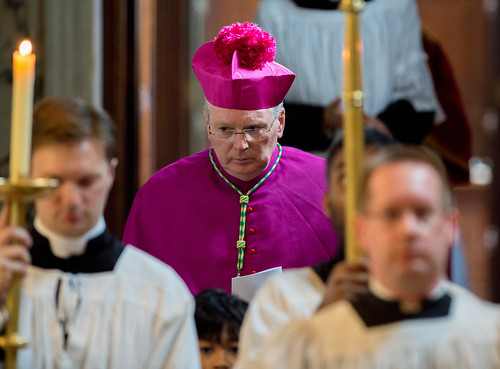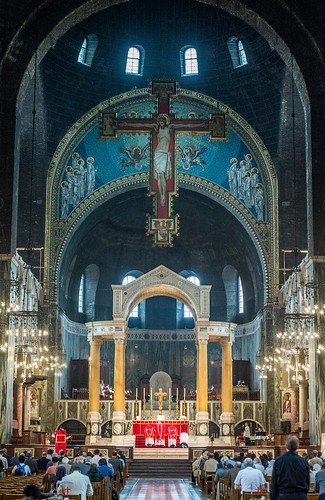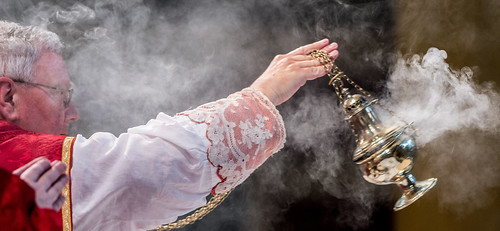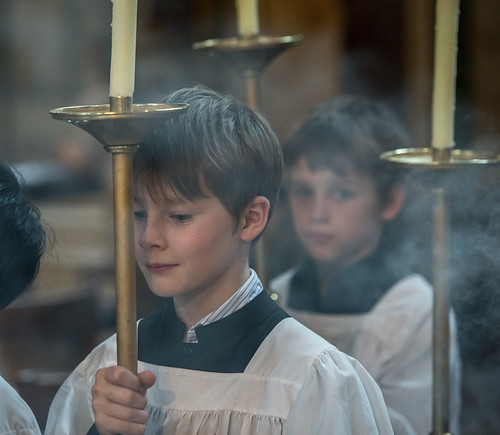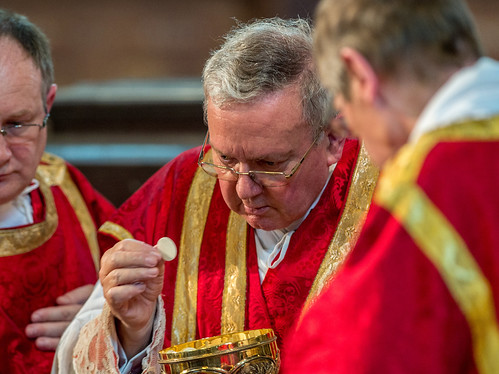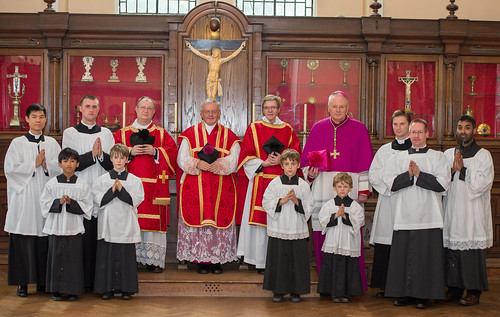Chairman's Blog
The Sacra Liturgia Conference has set the cause of the Reform of the Reform back by 20 years. That may not be a bad thing.
The reactions to Cardinal Sarah's words encouraging celebration of Mass 'ad orientem', with the priest facing east as the congregation does, continue to reverberate. In addition to a 'clarification' by the Vatican spokesman, Fr Lombardi, and a letter from Cardinal Nichols to the priests of Westminster Diocese, we have now had a letter from the Chairman of the relevant committee of the US Bishops' conference. All these statements point out that Cardinal Sarah's comments do not change liturgical law, and in slightly different ways claim that the current law favours celebration 'versus populum,' with the priest facing the people. The US letter asserts that a decision to change from vs. pop. to ad orientem celebration by a priest should only be done with the knowledge and approval of the bishop.
None of these statements, any more that Cardinal Sarah's, have in themselves the force of law. Nevertheless, they make public, clear, and official, a view which was up to now not so public, not so clear, and not so official: that celebration vs. pop. is officially favoured to the point that celebrating ad orientem needs, at least, special justification.
The kind of initiatives in which the 'Reform of the Reform' (RotR) consists, at the local level, depend on a degree of ambiguity about what is allowed or favoured by the rules. Such ambiguity abounds in official documents. Are altar girls permitted or actually favoured? Female lectors? Communion under both kinds? The use of the Roman Canon? Silent recitation of the Offertory? The sign of peace? Concelebration? The debate about the rules (unlike the debate on the underlying theology) is not only endless, but both exceedingly boring and ultimately pointless. It suffices that conservative and liberal priests alike can claim a degree of leeway and, when the pastoral and political conditions permit, quietly move things in their favoured direction. The golden rule in such matters is that you don't press for clarification unless you are sure things will be clarified in your favour.
This is the rule apparently forgotten by the organisers of the Sacra Liturgia conference, and their friends in the Catholic media, both on and offline. I certainly don't attribute any blame to Cardinal Sarah, who said nothing more in London than what he has said, without any bad results, on the record before, and, if anything, less than what Cardinal Ratzinger said in the Spirit of the Liturgy in 2000 and Cardinal Schonborn said in a retreat he preached to Pope St John Paul II in the mid 1990s (it was published as 'Loving the Church' in 1996). The problem lay in the hype heaped on his words by others. Not only was the hype false - as just noted there wasn't anything new or big about what he said - but it meant that Cardinal Nichols, Fr Lombardi, and all the others felt that they had to respond. And what sort of response did the organisers imagine they would get? What sort of official atmosphere do they imagine pertains in the Church right now? Where, in heavens' name, have they been for the last few years?
It is this which has put the cause of the Reform of the Reform back by twenty years - back before Cardinal Schonborn's cautiously worded but carefully argued and impassioned plea for worship 'obviam sponso', 'facing the bridegroom', twenty years ago. Is it conceivable, now that Fr Lombardi has nailed the Holy See's colours to the mast, that such an argument could be made in the presence of the Holy Father now? I don't think so either.
Behind this tactical blunder lies a more fundamental strategic mistake. The organisers of the Sacra Liturgia conference were keen to present the whole thing as about the Reform of the Reform rather than about the promotion of the Traditional Mass. The Traditional Mass was included just as part of the Church's rich pattern, and not as in any way a key element. The idea is that too-obvious association with the EF is politically disadvantageous: it is safer to present oneself as wanting to tinker with the (when properly understood, wonderful wonderful) liturgical reform, rather than as rejecting it.
The argument would seem to make sense, but people have been making it ever since the Novus Ordo Missae appeared in 1969, and it has never worked. The first problem is that the things the RotR people want, particularly celebration ad orientem, are interpreted as a de facto rejection of the reform as a whole by overwhelming powerful forces in the Church. I noted in a previous post that this view has its own logic; for present purposes it suffices to note that it is not going away. An auxiliary consideration is that it is suspected, with perfect justice, that many RotR advocates actually want the Traditional Mass anyway.
The second aspect of the mistake is that the Traditional Mass is not today seen as a poisonous, problematic thing at an official level in the Church. Although a much more radical departure from the reformed Mass than RotR ideas, it is treated much more leniently. Cardinal Nichols doesn't fancy his priests celebrating the OF ad orientem, but asked two of them to learn the EF to expand Sunday provision for it in his diocese. Religious Institutes committed to the Traditional Mass are welcomed into dioceses all over England, the USA, and indeed the world, by bishops who are never going to get rid of Altar Girls, Eucharistic Prayer 2, or communion in the hand, in the Ordinary Form.
The reason is not difficult to understand. The Reform of the Reform has the potential, if widely taken up, to turn dozens of parishes into liturgical war zones. Priests who take a stand on any of the major RotR issues can expect confrontations with parishioners with complaints going to the Bishop. People walk out of Mass; there are shouting matches. The development of the Traditional Mass in a diocese works in a completely different way. Here a bishop saves a historic church by giving it to a traditional Institute. There a priest introduces an extra Mass into his timetable for a handful of parishioners. People might complain but the complaints are obviously unreasonable, since it doesn't affect their own spiritual lives. No one need walk out of his favoured Mass never to return. No one has had his spiritual peace shattered. But in the meantime these initiatives have the potential to grow. They draw in the lapsed, they foster vocations. We don't pull down; we build up.
Hard-core RotR advocates will tell us that this is no way to restore the Church. They say we have to 'save' the OF because that is what nearly all Catholics attend. They like to imagine that celebration ad orientem could be rolled out in dozens of parishes in a short time, and that it would be a huge step forward. I don't disagree with the theological arguments they advance; I would just like to point out the real world - that annoying thing which gets in the way of so many fine theories. In this real world, which I at least am condemned to inhabit, this plan is not working. What is working is the steady advance of the Traditional Mass, which give people not a peculiar compromise liturgy, but a coherent liturgical and spiritual life.
There is something else as well. I don't bring to this debate many decades of personal experience. But I have already seen one of the consequences of the Reform of the Reform movement which its advocates are not so keen to advertise. That is sincere and zealous priests having nervous breakdowns. I apologise for putting it here in black and white, but it is something we should face. If you are telling priests to adopt a plan of action, you need to think through the consequences. Putting priests into massive unavoidable conflict has predictable results. Many priests have told us of the spiritual consolations accorded to them by learning and saying, even if only in private, the Traditional Mass. This is something which we can help them do which will be good for them, and if good for them then good for their parishes. Having arguments with Tablet-reading members of the parish liturgy committee does not pack the same spiritual punch.
So perhaps it is not such a bad thing, all things considered, that the cause of the Reform of the Reform has been set back by twenty years.
Support the work of the LMS by becoming an 'Anniversary Supporter'.
Young Catholic Adults: annual retreat at Douai
During the weekend of the 28-30 October 2016, Young Catholic Adults will be running a national weekend at Douai Abbey, it will be led by Fr. Thomas Crean O.P. The weekend will be full-board. YCA will be running the weekend with the Schola Gregoriana of Cambridge of Cambridge who will be holding Gregorian Chant workshops.
There will also be a Marian Procession, Rosaries, Sung Masses, Confession and socials. All Masses will be celebrated in the Extraordinary form.
Please note to guarantee your place this year Douai Abbey have requested that everyone books in 3 weeks before the start of the weekend i.e.7th Oct 2016.
For online booking please see:-
https://v1.bookwhen.com/yca-
Support the work of the LMS by becoming an 'Anniversary Supporter'.
Islam and the decadent West
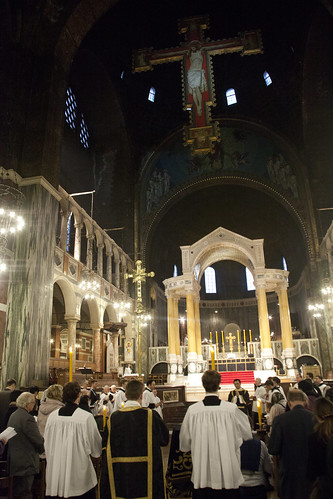
Reposted from last November, in light of the new massacre, in Nice. Requiescant in pace.
---------------------------------
I've not had time to write anything about the terrible massacres in Paris. It was good to be able to attend a solemn Mass for the dead the day after the killings had taken place. Every Mass for the dead, and practically all traditional prayers for the dead, even if they are for the benefit of a specific person or group of persons, is also for 'all the Faithful departed'.
May they rest in peace. And may God protect us all from an unprovided death.
I've done a number of blog posts criticising the approach to understanding and tackling Islam taken by various people, notably the zealous Evangelical David Wood, and the American Syrian Catholic Robert Spencer. In the comments to one of these posts a reader recommended a book by a Jesuit who hails from the Levant, Samir Khalil Samir, which proved to be excellent. Samir has given a very interesting interview to Edward Pentin, in which he explores the way the West is seen from the Arab Muslim perspective, an important factor, obviously, in these attacks.
Here are some extracts:
Muslims know that modernity is coming from the West; this is a fact. Now they see the West as having lost its ethics, especially on sexual questions. They’re very shocked by what they see or hear. … So they say this comes from modernity. They want to reject the excesses and abuses of some principles, but end up rejecting the whole thing. The problem is that the West is responsible, without knowing it, of the reaction of the Muslim world.
...
When Muslims see that, they immediately recall that homosexuality is absolutely condemned in the Quran, with reference to the biblical Lot. See chapters 7: 80-81; 11: 77-82; 15: 58-74; 21: 74; 26: 165-166; 27: 54-55; 29: 28-30; 54: 33-34. In some cases, they were burned alive. Then the Muslims say, “Okay, the West is Christian, Christianity allows this, and so Christianity is not the true religion; it’s a false religion. And we want to be true, to stick to the Quran and to the tradition.”
This means we are partly, indirectly responsible for the fanaticism that is spreading more and more in Islam, as a reaction to the West — not only, but this also — and playing a role in the radicalization of Islam.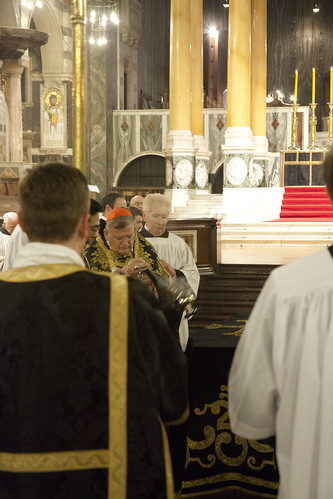
We have to be careful, in responding to terrorism, that we don't allow acts of terror to give a kind of legitimacy and political importance to extreme views, views unpopular even with an ethnic or religious population the terrorists claim to represent. 'Most Muslims reject the ideology of ISIS', goes the mantra, and I have no doubt that it is true. What we do need to do, however, is to consider the issues which give terrorists whatever degree of popular support they do have, for by dealing justly with the legitimate concerns of the population from which the terrorists come, one can begin to drain the swamp.
The Eagles Of Death Metal band was in the middle of the show when the assailants attacked the Bataclan.
Pseudonym of its singer: The Devil Jesse Hughes. In a European tour to defend their new album Down Zipper (!), the first in seven years, the rockers were playing on stage the Title: Kiss the Devil when the first shots were heard inside the room…
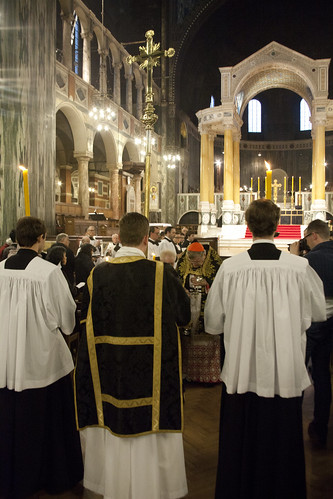 Western culture has major aspects which are an affront to God, to the Natural Law, and to Reason. What I have argued here, is that what we urgently need is a critique of the decadent West which is specifically Catholic, at once sane and radical. As I wrote:
Western culture has major aspects which are an affront to God, to the Natural Law, and to Reason. What I have argued here, is that what we urgently need is a critique of the decadent West which is specifically Catholic, at once sane and radical. As I wrote:"The problems posed by the de-secularisation of the world are not going to be solved overnight, but we can do something to stop making things worse. We can assert the Catholic critique of the decadence of Western culture, especially sexual culture. If there is one concrete gesture which might make those being drawn towards militant Islam stop and think that, perhaps, the Catholic Church may not be part of the problem they are trying to address, then it might be the restoration of head-coverings in church by Catholic women in the West. This would signal a rejection of both decadent sexual mores and of the attack on the difference between the sexes.
"Contemplate the likelihood of this happening any time soon, and you will glimpse the depth of the problem."
Support the work of the LMS by becoming an 'Anniversary Supporter'.
Book now for the Walsingham Pilgrimage!
There is a deadline: Monday 15th August. This is necessary for the caterers and other aspects of the pilgrimage; please don't try to book after that date! Do it before! Do it now!
The Pilgrimage runs from Thursday 25th (we gather in the afternoon and evening in Ely) to Sunday 28th, when we have our big Mass in Walsingham at 2pm, followed by a procession to the site of the Holy House. Some stay the night in Walsingham but it is possible to get back to London on Sunday. If you stay until Monday morning, we have another Mass, sung, in the Slipper Chapel at 10am.
We walk over three days the 55 miles from Ely to Walsingham, accompanied by the Traditional Mass and devotions, in the spirit of the great Chartres Pilgrimage.
Here is a little video about it. The booking page has lots more information.
It is an unforgettable experience, plus hot evening meals!
Show your devotion to Our Lady, walk in the footsteps of your Catholic predecessors, do some penance and take some important intentions to the feet of the Lady of Walsingham.
The cost is £75 for an adult, if you are an LMS member - and you can join at the same time.
There are generous discounts for students, and all are welcome.
Book here.
 |
| Procession along the 'Holy Mile' to the site of the Holy House in Walsingham, from the Slipper Chapel and Catholic Shrine |
Support the work of the LMS by becoming an 'Anniversary Supporter'.
Last call: SCT Summer School 2016
The dates are Sunday 24th July to Sunday 30th July.
This is something I've been doing since 2005, and it is one of the most exciting, and (for me!) exhausting event I'm involved in each year. We have a little school, for just a week, with maybe 30-40 children: lots of interesting discussions, lots of prayer, lots of fun.
The Summer School is for children aged 11-18; there is NO FEE, parents and guardians make a donation at their discretion. It is run by St Catherine's Trust with the support of the Latin Mass Society.
Click here for our downloadable application form in PDF format.
Click here to apply online
It takes place at the Franciscan Retreat Centre at Pantasaph, 10 minutes from Flint station, half an hour from Chester. We can offer lifts there from London. It has a Pugin chapel, and is home to the National Shrine to St Pio of Pietrelcina (Padre Pio).
As well as liturgy and catechesis, the Summer School introduces children to wide range of subjects, including history, philosophy, history of art, Latin, music and drama, an ideal Catholic supplement to homeschooling or conventional schools, Catholic or not.
We have all sorts of children, from all over England and Wales, Scotland, Ireland, and a few from further afield. It is a great experience for them to meet children from like-minded families, and many come year after year. Don't let your children miss out!
Support the work of the LMS by becoming an 'Anniversary Supporter'.
SPUC Conference
Details and booking here.

Support the work of the LMS by becoming an 'Anniversary Supporter'.
Video intereview with Gloria TV
Last October, when I was in Rome for the FIUV General Assembly and the Summorum Pontificum Pilgrimage, I was interviewed by Eva Doppelbauer of Gloria TV. Here is the result.
Support the work of the LMS by becoming an 'Anniversary Supporter'.
First High Mass for Fr Mawdsley: photos
Fr James Mawdsely celebrated a High Mass in St Mary's, Warrington, the FSSP church. As is usual at such Masses, because he is a new priest he has an 'assistant priest' (as a bishop does at Mass), so there are four sacred ministers, not just three.
Wednesday 13th July, 7pm.
Solemn High Mass at St Joseph’s, Gateshead, NE8 1LX.
Thursday 14th July, 12noon.
Low Mass at SS Joseph, Patrick & Cuthbert’s, Coxhoe, Co Durham, DH6 4DA.
Friday 15th July, 6pm.
Low Mass at St Andrew’s, Ravelston, Edinburgh, EH4 3DS.
Saturday 16th July, 12noon.
Solemn High Mass at the Church of the Immaculate Heart of Mary, 162 Broomfield Road, Glasgow G21 3UE.
Sunday 17th July, 11am.
Solemn High Mass at St William of York, Reading, RG1 5JP.
Support the work of the LMS by becoming an 'Anniversary Supporter'.
Cardinal Sarah on Liturgical Orientation
 It it always interesting to see arguments about liturgical orientation, the priest 'facing east' in Mass, since this is an important characteristic of the Church's liturgical tradition. Cardinal Sarah mentions it in a list of things which might be done to make celebrations of the Ordinary Form more worthy, along with a greater use of Latin, kneeling, and the discouragement of photography. It is not exactly a full-dress treatment of the issue, and nor is it new. In his talk he refers back to an article he wrote for Ossovatore Romano and the work of Pope Benedict. He could equally have referred to the writings of Cardinal Schonborn, who is quoted in the FIUV Position Paper on Liturgical Orientation. In this particular talk, Cardinal Sarah throws it out as a nice idea:
It it always interesting to see arguments about liturgical orientation, the priest 'facing east' in Mass, since this is an important characteristic of the Church's liturgical tradition. Cardinal Sarah mentions it in a list of things which might be done to make celebrations of the Ordinary Form more worthy, along with a greater use of Latin, kneeling, and the discouragement of photography. It is not exactly a full-dress treatment of the issue, and nor is it new. In his talk he refers back to an article he wrote for Ossovatore Romano and the work of Pope Benedict. He could equally have referred to the writings of Cardinal Schonborn, who is quoted in the FIUV Position Paper on Liturgical Orientation. In this particular talk, Cardinal Sarah throws it out as a nice idea:
This practice is permitted by current liturgical legislation. It is perfectly legitimate in the modern rite. Indeed, I think it is a very important step in ensuring that in our celebrations the Lord is truly at the centre. [Full text]
What is rather amazing, however, is the reaction to these remarks. Cardinal Nichols has written to his priests, the Vatican spokesman Fr Lombardi has made a statement, even Fr Spadaro SJ and Austen Ivereigh have felt the need to get in on the act: all with a view to contradicting the basic idea, that celebration facing east would be a good idea. Of course, they, like Cardinal Sarah, are all entitled to their opinions, and Cardinal Nichols is not just entitled, but obliged, to exercise prudential judgement in guiding his priests. The debate has been marred somewhat by a technical dispute over the correct translation of a passage in the General Instruction of the Roman Missal - this is the kind of tedious issue which those who are really interested can look up in a footnote in the Position Paper (see footnote 1). But let me say something about the bigger picture.
This debate is inevitable and intractable because both sides are right.
Cardinal Sarah, Pope Benedict, Cardinal Schonborn and Fr Michael Lang (in his book Turning Towards the Lord) are perfectly and undeniably correct that from a historical and theological perspective worship 'versus populum', facing the people, creates a problem. It doesn't invalidate the Mass or anything like that, but it is for practical purposes a massive rupture in historical continuity, for all the precedents which can be argued for it, and gives expression to a conception of the liturgy as (in the words of Pope Benedict) a 'closed circle', the community 'worshipping itself'.
Not only is this second point the impression gathered by those, like Pope Benedict, with an acute ear for what is going on in the liturgy, but it follows from what the supporters of vs. pop. celebration themselves say in its defence: that they want to engage face-to-face with the priest, that they prefer chairs-in-a-circle type celebrations, that they want to emphasise community, and so forth.
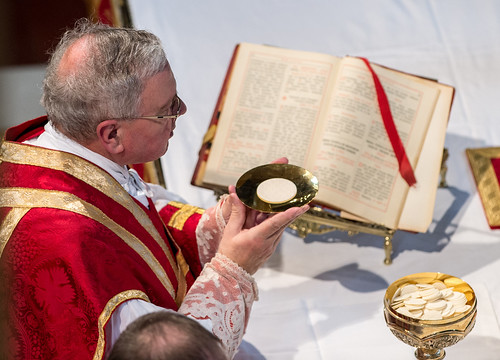 |
| Facing East to make the offereing. |
On the other hand, Cardinal Nichols, Fr Lombardi and the others are perfectly and undeniably correct that, for practical purposes, celebration vs. pop. is an integral part of the liturgical reform. Yes, celebrating the other way is allowed, as is celebrating in Latin. But in both cases the thrust of the post-conciliar documents is that these are things allowed for only in particular situations with particular justifications. For example, Latin is suggested for international gatherings. Celebration ad orientem is conceded, for example, where the altar cannot be moved away from the wall because of its historical or artistic value (see the Position Paper footnote 2).
Yes, it is true that the rubrics make reference to the priest turning around at certain points to face the people. (Fr Spadaro quoted one of these, apparently under the impression that it implied the celebrant faced the people all the time, when it does the opposite.) Well, they have to, if the concession is made that Mass can ever be celebrated ad orientem. And anyway, this is an amazingly weak argument. Just as--whatever Vatican II in Sacrosanctum Concilium said--Pope Paul VI told the world that the reform meant Mass in the vernacular, in the same way his big, media-event Mass to inaugurate the reformed Missal on the first Sunday of Advent 1969 was vs. pop.
Vs. pop. celebration is simply one aspect of a coherent programme of reforms which aimed at promoting a particular form of liturgical engagement. It goes with the use of easy-to-understand vernacular, the drastic reduction of the use of silent prayers by the celebrant, the replacement of the Church's musical patrimony with music the congregation can itself sing, the theological simplification of liturgical texts, and the shortening of lengthy ones. The multiplication of lay liturgical roles like readers and Eucharistic Ministers are a natural extension of the same idea. By all means let us discuss the success or failure of the project, by all means question the kind of participation being aimed at. But let's not pretend that there is a 'genuine reform', intended by some mysterious 'spirit of the Council', which comprises some of these elements and not others. They may not all have been mentioned in Sacrosanctum Concilium, and indeed official documents are in many instances in tension with each other, but they all pertain to a single conception of what liturgical participation means, and to this extent they stand and fall together.
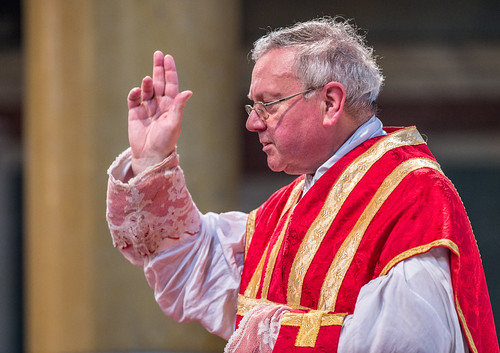 |
| Facing the people to give them a blessing. |
Those attached to the kind of liturgical participation brought in by the post-Conciliar reforms see, with varying levels of explicitness, worship ad orientem as a major step away from those reforms: and they are correct to do so. This is why attempts to introduce ad orientem can cause civil war in parishes. And the danger of civil war is one reason, I have no doubt, that it stimulates such a rapid response from people like Cardinal Nichols and Fr Lombardi.
The organisers of the Sacra liturgica conference, aiming to show that the Reform of the Reform agenda is still alive and kicking, have succeeded in showing just the opposite. There is absolutely no future in trying to inch back the reform in the teeth of this kind of opposition, any more than the First World War could be won by waves of infantry charging machine guns in order to gain territory a hundred yards at a time.
As I have argued on this blog before, it is a far simpler and generally more pastoral way forward for priests to introduce the Traditional Mass into the parish schedule, than to go to war over ad orientem and all the other issues in the Novus Ordo. Since, as I have argued, celebration versus populum is problematic, I admire and support priests who make the change to ad orientem in the Ordinary Form. What I can't do is defend them against the kinds of arguments which will inevitably be brought against them: that what they are doing is contrary to thrust of the post-Conciliar reform. Because it is.
I've written about the Death of the Reform of the Reform under its own label on this blog, and there are even more posts about the Reform of the Reform.
The turning around of the priest to greet the people during the Traditional Mass is itself an interesting topic, noted at the beginning of the Position Paper on the Kiss of Peace.
Support the work of the LMS by becoming an 'Anniversary Supporter'.
Photos of LMS AGM and Annual Mass in Westminster Cathedral
The AGM was addressed by Archbishop Thomas Gullickson, Nuncio to Switzerland and Lichtenstein.
Here he is chatting, over lunch, with one of the Latin Mass Society's Patrons, Lord Gill.
The Mass which followed the AGM was celebrated by our National Chaplain, Mgr Gordon Read. Archbishop Gullickson sat in choir.
Mgr Read was assisted by Fr Matthew Goddard FSSP (deacon), and Fr Mark Elliot Smith of the Ordinariate (subdeacon). We were blessed with three Fraternity seminarians in the serving team, including Matthew Palmer the Master of Ceremonies.
Support the work of the LMS by becoming an 'Anniversary Supporter'.


